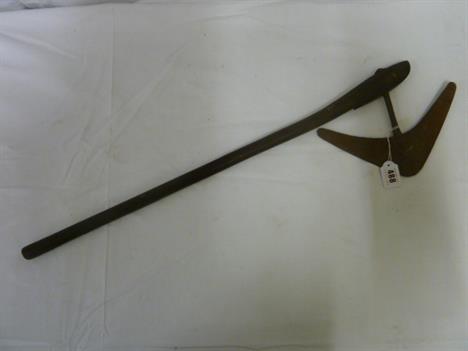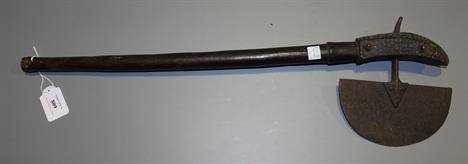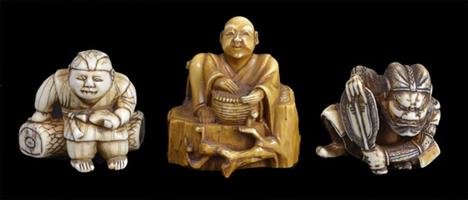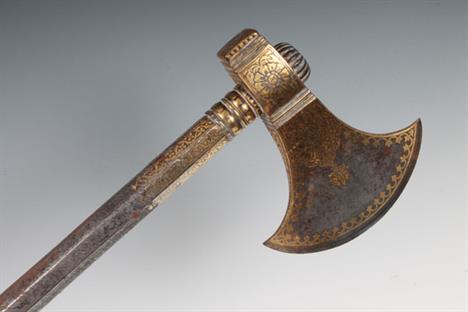14782 Preisdatenbank Los(e) gefunden, die Ihrer Suche entsprechen
14782 Lose gefunden, die zu Ihrer Suche passen. Abonnieren Sie die Preisdatenbank, um sofortigen Zugriff auf alle Dienstleistungen der Preisdatenbank zu haben.
Preisdatenbank abonnieren- Liste
- Galerie
-
14782 Los(e)/Seite
Louis John Rhead [1857-1926]- `He brought out one, in spite of its screams, into daylight`:- signed bottom left inscribed as titled along the bottom further inscribed Chap 18. Page 186 and with publishers copyright stamp Louis John Rhead [1857-1926] `He bought one out, in spite of it`s screams, into daylight` inscribed as titled along the bottom, further inscribed Chap 18 Page 186 and with publishers copyright stamp pen and ink drawing 46 x 34cm, together with Frederick Alfred Rhead [1856-1933] - Talkative at The Ale-Bench, an illustration from Pilgrims Progress Signed, pen and ink drawing and one other drawing of a woodman sharpening his axe.[3]
A Victorian Copeland Parian ware figure group "Paul and Virginia", he with a wicker style hat upon his shoulders, she with a nest of chicks, with sweetcorn resting close by, raised on a shaped base, stamped "Copeland" CONDITION REPORTS Wear, dirt and scuffs, some chips including to boy's left hand and to foliage, the end of the handle of the axe has hole to centre visible.
Akan. (Côte-d’Ivoire / Ghana). Elément de parure circulaire en « or fétiche ». L’axe creux servant de passant est recouvert d’une spirale de fil bordée d’un motif ajouré. Un crocodile « janus » est figuré sur toute la longueur de l’axe. D. 6,5 cm. Provenance: acquis de Patrick Girard en 2000.
TENOR DORLY (Edition limitée Squelette - 30 Exemplaires), vers 2000 Montre squelette à heure sautante réalisée en 30 exemplaires et dessinée par l’ingénieur René Bruyeron (créateur de la marque TOT). Boîtier en acier brossé à large lunette à vis bleuies, fond vissé de style hublot en verre minérale à mouvement apparent. Lecture de l’heure sur les 2 disques de chaque coté de l’axe (point rouge) de la trotteuse, disque à 9h pour les heures, à 3 h pour les minutes. Trotteuse centrale rouge et lecture du disque de date sur point à 6h. Poussoirs décoratifs sur la tranche, bracelet galuchat orange de commande et cuir crocodile neuf rapporté. Mouvement : Calibre mécanique remontage automatique signé TD / 1393 Swiss. Diam. 39 mm. État : Très bon état (Écrin plumier TD d’origine)
** A SAXON MINERS GUILD AXE, LATE 17TH/EARLY 18TH CENTURY with flat head formed with a characteristic spike fitted at the top with a brass bead, pierced with a slipped trefoil and six holes at the back (one hole broken out), the haft inlaid with numerous staghorn pellets and engraved stag horn rectangular plaques, the latter decorated with flowers and figures in contemporary dress, including the figure of Christ crucified on the back and a kneeling figure on each side of the head, horn basal cap engraved with the initials `IHN` beneath crossed mining implements and with a cross in splendour above (small cracks and repairs) 77 cm; 30 3/8 in overall
** AN INDIAN AXE, 19TH CENTURY with strongly curved blade terminating in a horned beast`s head, decorated on each side in soft metal with wild animals including elephants and tigers , incised socket, on its tapering hardwood haft studded with iron nails over brass foliate washers 51cm; 20 1/8 in overall
** AN AXE, PROBABLY FRANKISH, 6TH CENTURY with curved head of wedge-shaped section formed with a flattened rear face and integral socket (pitted), on a later wooden haft reinforced with an iron strip front and back 18 cm; 7 1/8 in Two axe heads of similar form attributed to the 5th/6th Century are preserved in the Museum für Deutsche Geschichte, Berlin. See H. Müller and H. Kölling 1990, p. 367, no. 60, 61
** A GERMAN FIGHTING AXE, LATE 16TH CENTURY with curved axe blade formed with a scalloped back-edge and pierced with six holes arranged in two equal groups, tall pyramidal robust rear spike, domed central finial, original haft encased in iron plaques and pierced for a thong, complete with original iron belt hook retained by a rivet with foliate head (lightly pitted throughout) 56.8 cm; 22 3/8 in overall
** A NORTH ITALIAN PARADE HALBERD, EARLY 17TH CENTURY, PROBABLY VENETIAN with curved slender axe-blade pierced with numerous shaped panels and engraved with scrolls, formed with a shaped lug top and bottom and fitted with a chased bronze grotesque boss on each side, pierced and engraved rear fluke decorated en suite and fitted with a further pair of bronze bosses, the centre fitted with a transverse bolt terminating in a pyramidal spike on each side, central blade of flattened-diamond section, pierced with three central slots and engraved with scrolls rising from a mask, fitted at the base with a characteristic openwork collar comprising six bars each interrupted by a cherubic mask, engraved socket, on an early wooden haft covered with red fabric, studded with brass nails and retaining three tassels and its iron shoe (haft worn and repaired, shoe incomplete) 55.2 cm; 21 3/4 in head A halberd of similar form is preserved in the Poldi Pezzoli Museum, Milan, cat. Nos. 526 and 527. Two others were sold in these rooms, 28th June 2006, lot 347 and 7th December 2006, lot 214 respectively.
** A GERMAN HALBERD, THIRD QUARTER OF THE 16TH CENTURY with forward-leaning axe-blade pierced with a quatrefoil, scalloped back-edge, two-stage central spike, the upper section of stiff-diamond section, rear fluke pierced with a slipped figure-of-eight shape, and a pair of long straps, on a later wooden haft 58.5 cm; 23 in head Provenance The Lord Astor of Hever, sold Sotheby`s London 5th May 1983, lot 145 to Stern.
** A POLEAXE, MID-17TH CENTURY, PROBABALY SWISS with slightly curved axe blade rising to a sharp central point, stamped twice on each side with a mark, a cross with the letter `O` above in a shaped recess, stout rear spike, and a pair of separate long straps, on a wooden haft 28 cm; 11 in head A related axe is preserved in the National Artillery Museum, Turin, inv. no. J. 4/5107, and another in the Schweizerisches Landesmuseum, Zurich. For the latter see Dr. E. A. Gessler 1928, table 12.
** A RARE BAVARIAN SABRE HALBERD, SECOND QUARTER OF THE 17TH CENTURY with curved axe-blade, very long slightly curved central blade formed with a hatchet point and a long fuller on each face, tapering socket with bevelled edges, on an associated wooden haft with four long straps 107.4 cm; 42 1/4 in head A large number of halberds of this form, formerly in the Bavarian arsenal, are now preserved in the Bavarian Army Museum, Ingoldstadt. Another example was sold in these rooms 10th December 2008, lot 185. See H. Seitz 1968, p. 216, ill. 221.
** A STYRIAN HALBERD, LATE 16TH CENTURY with forward-leaning axe-blade pierced with three holes top and bottom, a central group of five holes and incised with crescents, long central spike of diamond-section, rear fluke stamped with three pellets arranged vertically on each side and with a mark, and a pair of straps (one repaired), on a later wooden haft 72 cm; 28 3/8 in head
** AN AMERICAN HALBERD OF NEW ENGLAND TYPE, MID-18TH CENTURY with curved axe-blade pierced with a pair of rounded diamond-shaped apertures and pairs of slipped circles, matching rear-fluke, central leaf-shaped blade formed with an acute point, tapering cylindrical socket and a pair of straps, on a later wooden haft 46.5 cm; 18 1/4 in head Two related halberds are preserved in the Kretzchmar von Kienbusch Collection, The Philadelphia Museum of Art, cat. nos. 615, 618
A Spanish 1941 model bolo bayonet, a US M5 bayonet with nickel plated hilt, a Continental knife bayonet, probably Swiss, and a band sidearm, all with sheaths, and a group of further edged weapons, including a copy HJ knife, a jambia, a machete, a kukri, a fireman`s axe and a Continental officer`s sword with 18th Century style hilt and curved single edged blade, blade length approx 84cm (hilt crudely repaired).
ORIENTAL CARVED IVORY GROUP OF TWO FIGURES, one standing wearing a large straw hat, carrying an axe and basket of fruit on his back, the other small squatting figure holding a mallets and a chisel, on ivory circular base with two baskets of fruit, 5 1/4" high, 4 1/8" wide, incised signature on base (a.f.)
An Ivory Netsuke of a Woodsman, he sits on a fallen tree holding his axe on his lap and a sickle tucked into his obi, unsigned, 19th century; and two other Ivory Netsuke, one of fierce General kneeling holding his uchiwa, the other of a farmer seated on a tree stump with a basket of seeds, the latter signed Kogyoku (3)
-
14782 Los(e)/Seite






![Louis John Rhead [1857-1926]- `He brought out one, in spite of its screams, into daylight`:- signed bottom left inscribed as](http://lot-images.atgmedia.com/SR/35518/2893366/278-2013122016719_468x382.jpg)



















































